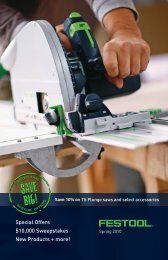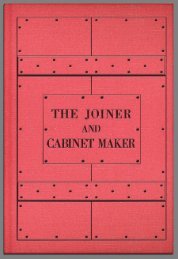Chris Pye Signature Slipstones - Tools for Working Wood
Chris Pye Signature Slipstones - Tools for Working Wood
Chris Pye Signature Slipstones - Tools for Working Wood
You also want an ePaper? Increase the reach of your titles
YUMPU automatically turns print PDFs into web optimized ePapers that Google loves.
By adding a short inside bevel of 5-10°, the overall angle of the 'wedge of<br />
metal' is increased to (20-30°), much tougher. The cutting edge is<br />
thrown towards the middle of the metal, buttressed on both sides.<br />
• The inside bevel lifts the shaving out of the gouge<br />
Shavings and chips tend to bind against the walls of deep and U-shaped<br />
gouges as they run up the 'cannel' (the inner trough). An inner bevel<br />
eases the shaving out of the gouge by breaking and lifting the chip.<br />
Do all carving tools have inside bevels?<br />
The general principle is that the more the gouge is used upside down, the<br />
more inside bevel is needed. (There are a few exceptions to this, such as<br />
pea or bead mouldings where the 'self-jigging' action of the edge is a<br />
benefit to cutting the extremely tight curve required).<br />
The flatter the gouge, the more inside bevel it will have and the more the<br />
inside bevel is an advantage. Deep gouges have a short inside bevel. Bent<br />
gouges and V tools have none.<br />
Carvers experiment and find the right amount of inside bevel that suits<br />
them, their tools and their style of carving.<br />
Why don't gouges come with inside bevels already present?<br />
Today, many carvers are self taught and assume the manufacturers give<br />
them correctly sharpened tools. However, 'ready sharpened' gouges are a<br />
modern phenomenon. In the past gouges were bought 'set but not<br />
sharpened', with the outer bevel roughly ground to shape.<br />
Carvers sharpened their own tools in the way that that suited them.<br />
Carvers vary in their approach to carving and thus the way they like their<br />
carving tools configured (and this configuration does alter somewhat with<br />
hardness of wood etc).<br />
New carving gouges may be 'sharp' but not cut well: the outer bevel all<br />
too commonly has too high a cutting angle, and the gouge cannot be used<br />
upside down so well <strong>for</strong> lack of the inside bevel. These features need to be<br />
corrected and carving tools 'commissioned' be<strong>for</strong>e arriving on the bench.<br />
Carving tool manufacturers sell carving tools. Adding an inside bevel is an<br />
extra step and thus manufacturing cost when they can rightfully expect<br />
carvers to sharpen their tools in the way that we would expect a violinist<br />
to tune their violin.<br />
<strong>Chris</strong> <strong>Pye</strong>: <strong>Signature</strong> <strong>Slipstones</strong> ©19 July 2007<br />
4













